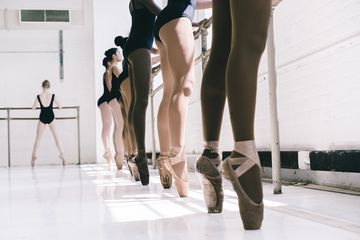When the Manhattan Sideways team and I visited the Dance Theatre of Harlem in 2017, we were greeted by Robert Garland, the director of the school and the resident choreographer. He was eager to give us a personal tour of the space and to share their remarkable story with us. Since our visit was in the summertime, regular classes were not in session. Instead, we observed their Summer Intensive program, which Robert told us features the “crème de la crème of the youth dance scene. ” Every year, the school holds a national audition tour to select participants for the program, though the Summer Intensive also has many returning students. In fact, Robert has known some of these aspiring dancers since they were only seven years old. During our first visit, we sat in on a beginner’s pointe class, a modern dance class, and a men’s class. It was heartwarming to see the kids’ engagement, as they were instructed with equal measures of discipline and fun. They were happy to show us heir latest lesson in properly tying the ribbons on their pointe shoes before going through their regular barre exercises. It was equally as exciting to return the following week for a chance to see the rehearsals for the dance company, where we glimpsed Robert in his role as resident choreographer. Beyond the actual dancing, we also observed examples of their supplementary studies, through which students can learn about dance history, musical theory, and a range of other subjects that complement their in-class training. The Summer Intensive, Robert explained, is basically a condensed version of what the Dance Theatre of Harlem does year-round. The school is divided into different programs based on skill level, consisting of a Tendu Program for children between the ages of three and eight and Lower School and Upper School programs designed for progressively more experienced students. As an additional offering, the Dance Theatre has a Professional Training Program that grants participants a certificate upon completing three years of study. All programs follow the same methodology of exposing students to a wide range of styles and techniques, from tap to jazz to West African, while simultaneously providing them with a well-rounded understanding of the craft via supplementary studies. These studies even include subjects like sewing and costume design, educating students in anything that might prove relevant to their possible futures as dancers. We were impressed to learn that Dance Theatre of Harlem does not stop at being a school and dance company; it also has a community outreach program through which it holds workshops and assemblies in public schools to expose children to the arts. This is in addition to the Sunday Matinee series, during which students of the company perform for the public, and audience members are encouraged to meet the artists after a show. After receiving a tour of the space and a taste of the usual class routines, we sat down with Robert to hear a bit of history of the school. It was founded in 1969 by Arthur Mitchell and Karel Shook, two renowned figures in the dance world. Mitchell, a MacArthur Fellow and National Medal of Arts recipient, was the second African American member of the New York City Ballet, where he remained for eleven years. He helped establish dance companies in Washington, D. C. and Brazil before deciding to form his own dance company in Harlem, the neighborhood where he was raised. His decision was motivated by the assassination of Martin Luther King Jr., since it sparked in him a desire to create better opportunities for young people in his community. Robert proposed a partnership with Karel Shook, another former member of the New York City Ballet, who was well known as a ballet instructor and had established the Studio of Dance Arts. Together, they launched Dance Theatre of Harlem with a mere thirty students in the basement of St. James Presbyterian Church on 141st street. Within two months, however, the school grew to five hundred students. Two years later, the company had its debut performance, making history as the first African American ballet company. Because of rapid expansion, the school quickly needed a new location. When Mitchell got wind of a former garage available on 152nd street, he transformed it into the high-ceilinged, well-equipped dance studio that still houses the school today.
